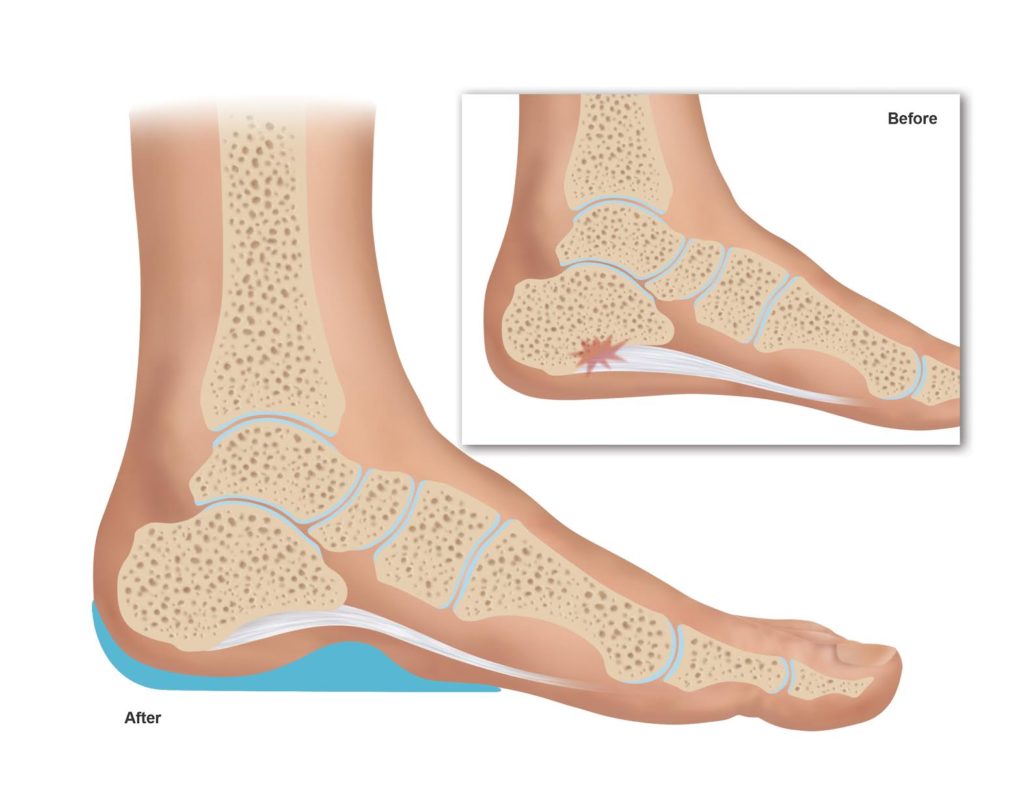 The human body can be a big mystery–particularly when it comes to pain.
The human body can be a big mystery–particularly when it comes to pain.
You know your feet and heels hurt.
But why?
Is it plantar fasciitis, heel spurs, or something different? The hope of finding out exactly what’s going on beneath the surface encourages many people to seek out X-rays to determine the exact cause of heel or foot pain. After all, a Superman-style peek into the inner workings of your feet should reveal all, right?
Unfortunately, it’s not quite that simple when it comes to X-rays and plantar fasciitis or heel spurs.
While X-rays may be helpful in many cases, they’re not quite a magic bullet for diagnosing the root cause of heel pain. Here’s everything you need to know about X-rays and plantar fasciitis:

Are X-rays Needed to Diagnose Plantar Fasciitis or Heel Spurs?
While X-rays are a popular first line of defense when it comes to determining the cause of foot pain, they aren’t particularly helpful in diagnosing plantar fasciitis. Why? In large part because X-rays are much better at showing bones rather than soft tissue like muscles and ligaments. And since the main player in plantar fasciitis is a ligament–the fascia or arch of your foot–it’s difficult to determine the presence or extent of damage through an X-ray.
X-rays can detect the presence of heel spurs–sharp, protruding calcium deposits that may dig into the fatty pad of the heel, causing pain. However, the presence of heel spurs does not necessarily mean that someone has plantar fasciitis. While plantar fasciitis can cause the development of heel spurs as the body attempts to compensate for the damaged fascia, at other times heel spurs develop independently of plantar fasciitis and do not cause pain.
What Can X-rays Do?

While X-rays aren’t particularly good for diagnosing plantar fasciitis, they can rule out other causes of foot pain, including stress fractures, cysts, and other problems related to the bones of the foot and ankle.
If your heel and foot pain does not respond to conservative home treatments for plantar fasciitis, your doctor may recommend an X-ray to explore other potential causes of the pain you are experiencing.
Typically, unless you’ve been experiencing heel pain for more than six months, your doctor will base his or her diagnosis on your reported symptoms along with an examination of your foot, heel, and ankles.
Costs for Foot X-rays
For individuals who do not have health insurance, the cost of a foot X-ray can be spendy, ranging between $200-$1000 depending on the provider, location, and how many views of the foot are taken during the X-ray session.
Even for individuals with health insurance, the out-of-pocket cost for a foot X-ray to diagnose plantar fasciitis can be expensive. Many insurance companies cover only a small percentage or nothing at all for X-rays to diagnose plantar fasciitis, especially as a first resort. Before you decide with your doctor that X-ray is the right diagnostic tool for your heel pain, make sure to speak with your insurance provider to avoid surprise expenses.
Alternatives to Plantar Fasciitis X-rays

Overwhelmingly, if you are experiencing heel pain–particularly with those first few steps in the morning–you probably have plantar fasciitis. Diagnosing this condition is typically a straightforward process that involves evaluating your symptoms in light of your habits, lifestyle, and other risk factors for plantar fasciitis (like your footwear). Your doctor can typically make an accurate diagnosis based on your answers to questions about exercise habits, when you experience foot and heel pain, and when your pain gets worse.
In some cases, your doctor may recommend an ultrasound scan–which is far more useful for examining soft tissue. Ultrasound may reveal a thickened plantar fascia (which can indicate plantar fasciitis), tears in the fascia, and may also detect or rule out bursitis, abscesses, rheumatoid arthritis, entrapped nerves, and gout.
If your symptoms persist, get worse, or you and your doctor suspect that another issue may be mimicking plantar fasciitis, next steps include tests that evaluate blood flow, bone scans, an MRI, or neurological testing to rule out nerve entrapment.
The good news is that the overwhelming majority of plantar fasciitis cases can be treated at home with simple, conservative treatments such as icing, stretching, rest, and the use of plantar fasciitis orthotic inserts. With a few months of consistent attention and treatment, most people find significant relief from their symptoms.




I fell and somehow injured my right heel. This happened today and the pain is getting worse and it’s starting to swell and take on that blue color. Can you break a heel? I have to walk on my right toes. Any time my foot touches the floor it’s extremely painful. Should I have it x-rayed or will it heal on its own?
Hi Beverly! It is definitely possible to break your heel, or one of the many bones of the foot. It sounds like a doctor’s visit might be a good idea 👩🏽⚕️👨⚕️
I have been experiencing heal pain for about three months…its excruciating pain!My dr put me on gabapentin but it doesnt seem to help,I’m on my feet all fsy,so resting it is not an option…i have tried stretching,and putting ice on it…is there anything else you can suggest?
My wife works and cant stand more than a few hours. And she gets pain in her feet. Mainly heel pain, on the shoe it mainly wares the back of shoe. Any help?
I had a x-ray taken of my right foot on 3/9/2018 and it showed i heel spurs. I had another x-ray taken of my right foot on 4/18/2018 and it showed normal is this possible when I still have pain.
When I was five years old I began having problems with my feet. I was in pain but don’t remember the exact place of the pain. I remember seeing xrays of my heels and they looked like there were tiny holes in the bone. I also remember something about my ankles and the possibility of them ‘freezing’. I was treated with short casts, off and on, and a stirrup to keep the weight off my foot. What could this be?
My pain started suddenly. It felt like a nail was piercing my heel while resisting my legs on an ottoman. Could it be a laser weapon piercing? Pain started right after feeling the nail like force enter my body. This isn’t plantar fasciitis, it’s a weapon injury,
I was at a swimming pool and slid down this slide. I guess your supposed to keep your feet up! I hit the bottom with my heel.
I knew I bruised it. There was no bruise marks or anything. So I did my best to stay off it. I am on my feet a lot at work!!
It’s now been about 2 months.
I read that I could have taped it? It’s almost heeled, there is still a spot that is tender only feel it when walking. If I push on it with my hand I don’t feel it!
Should I just hang in there, should I go ahead and wrap it? Thanks so much, Angela